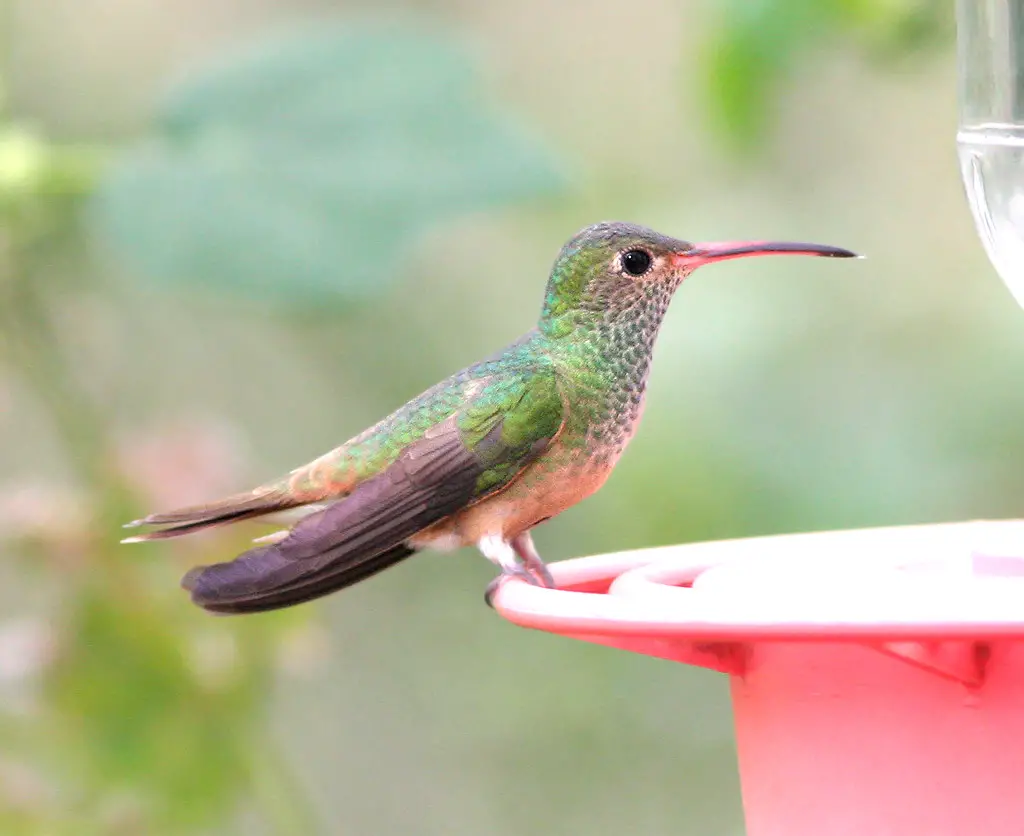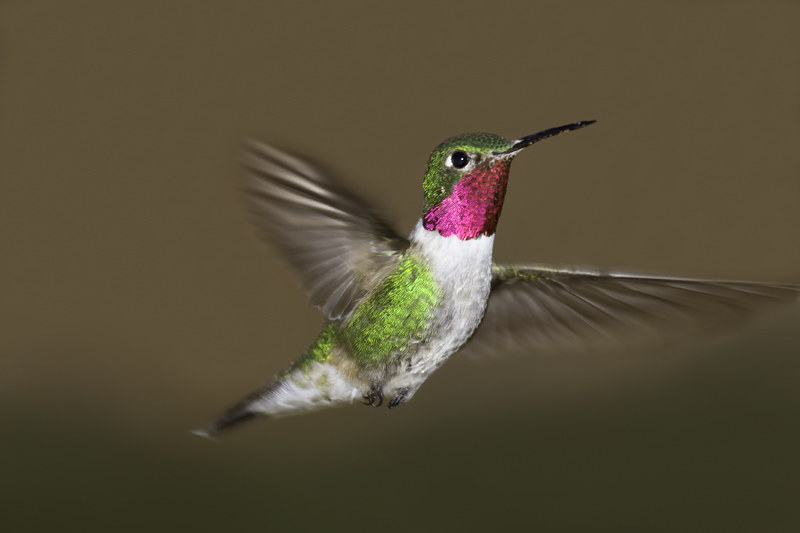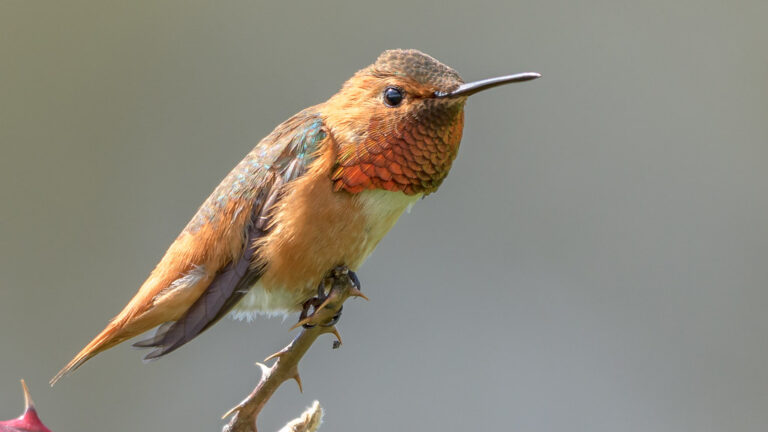South Carolina is a state known for its charming southern hospitality, delicious cuisine, and beautiful beaches. However, it is also home to a wide variety of wildlife, including several species of hummingbirds. In this post, we will explore the different types of hummingbirds in South Carolina, their habitats, behaviors, and conservation status.
From the stunning and vibrant Ruby-throated Hummingbird to the rare and elusive Rufous Hummingbird, we’ll take a closer look at these fascinating birds and their roles in South Carolina’s ecosystems. We’ll also provide tips on how to attract and observe these birds in your backyard, as well as some resources for further reading and exploration.
Whether you’re an avid birdwatcher, a nature enthusiast, or simply curious about the wildlife in your area, we invite you to join us on a journey to discover the amazing world of hummingbirds in South Carolina!
12 Types of Hummingbirds in South Carolina
- Black-Chinned Hummingbird
- Ruby Throated Hummingbird
- Broad-Billed Hummingbird
- Blue-Throated Mountaingem
- Anna’s Hummingbird
- Allen’s Hummingbird
- Broad-Tailed Hummingbird
- Buff-Bellied Hummingbird
- Calliope Hummingbird
- Mexican Violetear
- Rufous Hummingbird
- Green-Breasted Mango
Ruby-throated Hummingbirds

Image Source
- Scientific name: Archilochus colubris
- Lifespan: 3 to 5 years in the wild
- Weight: 2.5 to 4 grams
- Size: 7 to 9 cm (2.8 to 3.5 inches) in length, with a wingspan of 8 to 11 cm (3.1 to 4.3 inches)
- Origin: Found throughout eastern North America, from southern Canada to the Gulf of Mexico, as well as in some parts of Central America during migration.
The male Ruby-throated Hummingbirds have an iridescent red throat, and both sexes have bright green throats and back with gray-white undersides. Female Ruby-throated Hummingbirds have white undersides, greenbacks, and brownish crowns and sides.
The only hummingbird species that breeds in eastern North America is the Ruby-throated Hummingbird, which subsequently migrates farther south to Central America. Some travel across Texas along the coast or over the Gulf of Mexico. For breeding, they begin to arrive in the deep south in February and may not reach the northern states and Canada until May. They go south In September and August.
These little birds fly from one nectar source to another, catching insects in the air or on the webs of spiders. They will sometimes rest on a tiny branch, but because of their short legs, they can only shuffle along a perch and can’t walk.
The best locations to look for them outside in the summer are flowering gardens or forest margins. They are very widespread in urban areas, particularly around nectar feeders.
Male Ruby-throated Hummingbirds are aggressive in the protection of feeders and flowers. After mating, they do not stay around for very long and may migrate by early august.
Ruby-throated females make their nests on thin branches out of thistle or dandelion down that are bound together by spider silk. They lay 1-3 eggs that are only 0.6 inches in diameter (1.3 cm)
Black-chinned Hummingbird

Image Source
- Scientific name: Archilochus alexandri
- Lifespan: Up to 10 years in the wild
- Weight: 3 to 3.5 grams
- Size: 8.5 to 10.5 cm (3.3 to 4.1 inches) in length, with a wingspan of 11 to 13 cm (4.3 to 5.1 inches)
- Origin: Found in western North America, from the western United States to northern Mexico.
Black-chinned Hummingbirds have grayish-white undersides and dull metallic green backs. The females have a light neck and white tail feather tips, while the males have a black throat with a thin, iridescent purple base.
Black-chinned hummingbirds mostly breed inland in western states, and during the winter they travel to western Mexico and the Gulf Coast.
They eat nectar, tiny insects, and spiders. While consuming nectar, their tongues can lick 13–17 times per second.
Black-chinned Hummingbirds lay 2 white, tiny eggs that are barely 0.6 inches long in their nests, which are made of plant down and spider silk to keep them together (1.3 cm)
Black-chinned Hummingbirds often return to a favorite perch and are frequently seen perched at the tops of dead trees on small, bare limbs. They may be found among shaded oaks on the Gulf Coast or by canyons and rivers in the Southwest.
Buff-bellied hummingbird

Image Source
- Scientific name: Amazilia yucatanensis
- Lifespan: 3 to 5 years in the wild
- Weight: 5 to 6 grams
- Size: 10 to 11 cm (3.9 to 4.3 inches) in length, with a wingspan of 14 cm (5.5 inches)
- Origin: Found in the Gulf Coast region of the United States and eastern Mexico
The medium-sized Buff-bellied hummingbird has a red bill with a black tip, although the females have a darker beak.
Southern Texas, the Yucatan Peninsula in Mexico, and all the way up into Central America are breeding grounds for buff-bellied hummingbirds. The Buff-bellied Hummingbird makes brief winter migrations from the Gulf Coast to Louisiana and Florida.
They nest in Texas between April to august among low-lying big bushes or small trees. They may lay up to 2 eggs.
The optimal habitat for buff-bellied hummingbirds is semi-open areas or forest borders, however, they may also visit yards with flowers or nectar feeders. Their meals also include some small insects.
By the use of nectar feeders and red tubular flowers like Turk’s cap and red salvia, you can attract more Buff-bellied hummingbirds.
Rufous Hummingbird

Image Source
- Scientific name: Selasphorus rufus
- Lifespan: 3 to 5 years in the wild
- Weight: 2.7 to 4.3 grams
- Size: 7 to 9 cm (2.8 to 3.5 inches) in length, with a wingspan of 11 cm (4.3 inches)
- Origin: Found in western North America, from Alaska to Mexico
Rufous Hummingbirds are bright orange on the back and belly, have a white patch below the neck, and have an iridescent red throat. The females have a pale belly and a back that is greenish-brown and rusty in color.
As compared to their size, rufous hummingbirds have one of the longest migration routes, covering up to 4000 kilometers on each trip. They move south to Mexico and the Gulf Coast to spend the winter after breeding in northwest Alaska.
In the spring, they go north along the Pacific Coast, and in the late summer and autumn, they pass past the Rocky Mountains.
The main sources of food for rufous hummingbirds are nectar from vibrant tubular flowers and insects including gnats, midges, and flies. As they climb higher into the trees, they utilize spider webs and soft plant down to bind their nest together. They deposit one or two tiny, white, 0.5-inch (1.3-centimeter) eggs.
They are aggressive and will attack any hummingbird, even larger or resident during migration. They’re short-lived during migration and frequently hunt other hummingbirds. Mountain meadows and winter forests are their home.
Broad-tailed Hummingbird

Image Source
- Scientific name: Selasphorus platycercus
- Lifespan: Up to 12 years in the wild
- Weight: 2.8 to 4.5 grams
- Size: 9 to 11 cm (3.5 to 4.3 inches) in length, with a wingspan of 12 to 16 cm (4.7 to 6.3 inches)
- Origin: Found in western North America, from the Rocky Mountains to the Pacific coast.
Broad-tailed hummingbirds have iridescent green backs, brownish wings, and white chests and bellies. Females and youngsters have green dots on their cheeks and necks, while males have iridescent pink throats.
In the mountainous west, between late May and August, Broad-tailed Hummingbirds breed in high meadows and open forests between 5,000 and 10,000 feet in elevation before moving to southern Mexico for the winter.
The Broad-tailed Hummingbird may slow their heart rate and lower their body temperature to enter a condition of torpor because of the cold at higher altitudes.
These hummingbirds typically eat nectar from flowers and visit hummingbird feeders as well as drink from larkspur, red columbine, sage, and scarlet gilia. They use tiny insects to supplement their food and also feed insects to their young.
Often built on aspen or evergreen trees, Broad-tailed Hummingbird nests are lined with gossamer and spider webs to provide extra warmth on chilly evenings.
Anna’s Hummingbirds

Image Source
- Scientific name: Calypte anna
- Lifespan: Up to 10 years in the wild
- Weight: 3.5 to 6 grams
- Size: 9 to 11 cm (3.5 to 4.3 inches) in length, with a wingspan of 12 to 13 cm (4.7 to 5.1 inches)
- Origin: Found on the western coast of North America, from southern Alaska to Baja California
Little Anna’s Hummingbirds are mostly green and grey in color. The female’s neck is grey with spots of red whereas the male’s head and throat are iridescent reddish-pink.
Anna’s Hummingbird is the most common non-migratory hummingbird along the Pacific Coast. The males do a stunning dive performance during mating, climbing as high as 130 feet in the air before plummeting back to the earth while making a loud noise with their tail feathers.
While they may also be found in scrub and savannah, Anna’s hummingbirds prefer the backyards and parks with, vibrant flowers and nectar feeders.
The nests of Anna’s hummingbirds are located high in trees, between 6 and 20 feet above, and they often have two to three broods each year.
Calliope Hummingbird

Image Source
- Scientific name: Selasphorus calliope
- Lifespan: 3 to 5 years in the wild
- Weight: 2 to 2.5 grams
- Size: 7 to 8 cm (2.8 to 3.1 inches) in length, with a wingspan of 11 cm (4.3 inches)
- Origin: Found in western North America, from southern Canada to Mexico
The Calliope Hummingbird, the tiniest bird in America with the size of a ping pong ball, travels more than 5000 miles annually from Mexico to Canada and back. Moreover, they fight valiantly to protect their territory and even pursue Red-tailed Hawks.
Male Calliope Hummingbirds have shiny green backs and sides, brilliant magenta throats (known as the gorget), and black tails. The underside of females is more pinkish-white than white, unlike that of males, who have iridescent throats.
They migrate in spring from the Pacific Coast to breeding grounds in California, Colorado, and up to northern states and Canada, They migrate pretty early and arrive between the middle of April and the beginning of May.
Their nests are often found on evergreen trees and may be reused or built over an older nest.
Allen’s Hummingbird

Image Source
- Scientific name: Selasphorus sasin
- Lifespan: 3 to 5 years in the wild
- Weight: 2.5 to 3.5 grams
- Size: 7 to 9 cm (2.8 to 3.5 inches) in length, with a wingspan of 11 cm (4.3 inches)
- Origin: Found in western North America, from Alaska to Mexico
It may be difficult to distinguish Allen’s Hummingbirds from Rufous Hummingbirds in the little area of coastal woodland and scrub between California and Oregon that they inhabit.
Male Allen’s Hummingbirds have orange bellies, tails, and eye patches along with iridescent reddish-orange throats. The females lack the brilliant throat color, but both sexes have long, straight bills and coppery-green backs.
The Allen’s Hummingbird’s small outer tail feathers are what set it apart from Rufous Hummingbirds. They may have up to three broods a year and build nests at no particular height along shaded streams.
Allen’s Hummingbirds move up to the Pacific Coast in California and Oregon as early as January and spend the winter in Mexico. Some continue to live in Los Angeles and central Mexico.
Broad-billed Hummingbird

Image Source
- Scientific name: Cynanthus latirostris
- Lifespan: 3 to 5 years in the wild
- Weight: 3 to 4 grams
- Size: 9 to 10 cm (3.5 to 3.9 inches) in length, with a wingspan of 12 cm (4.7 inches)
- Origin: Found in southwestern United States and Mexico
Broad-billed hummingbird has bright colors even among the hummingbirds. The males have a deep metallic green color throughout, and their blue throats reach down to their breasts. Females have light bellies and both males and females have red beaks that are black-tipped and broad toward their heads.
Broad-billed can be found in central Mexico and along the Pacific coast of Mexico throughout the year. Some birds spend the whole year close to the Mexican border, while others travel north to breed in mountain valleys in southern Arizona and New Mexico.
Broad-billed Hummingbirds prefer to forage in canyon streams and alpine meadows, although they will also visit garden feeders. They build their nests around streams at a relatively low height of about 3 feet.
Mexican Violetear

Image Source
- Scientific name: Colibri thalassinus
- Lifespan: Up to 8 years in the wild
- Weight: 6 to 7 grams
- Size: 9 to 10 cm (3.5 to 3.9 inches) in length, with a wingspan of 12 to 14 cm (4.7 to 5.5 inches)
- Origin: Found in montane forests of Mexico and Central America.
Mexico Violetears are medium-sized hummingbirds that have violet spots on the sides of their heads and breasts and are metallic green overall.
Mexican Violetears may be found as far south as the highlands of Bolivia and Venezuela. They breed in forests in Mexico, Central America, and Nicaragua. In particular in Central and Southern Texas, non-breeding Mexican Violetears have been seen to travel northward into the United States.
Green-breasted Mango

Image Source
- Scientific name: Anthracothorax prevostii
- Lifespan: Up to 10 years in the wild
- Weight: 7 to 9 grams
- Size: 10 to 12 cm (3.9 to 4.7 inches) in length, with a wingspan of 14 to 16 cm (5.5 to 6.3 inches)
- Origin: Found in the Caribbean and South America, from Venezuela to Brazil and Bolivia.
Male green-breasted mangoes have a blackish neck edged with blue on the chest, and their backs are glossy and brilliant green. Females have a black stripe running down the center of their white undersides, along with a few metallic blueish-green feathers.
The coastlines of Mexico, Central America, and portions of northern South America are home to green-breasted mangoes. Tropical deciduous woods, gardens, and a few open or moderately forested regions make up their habitat.
Blue-throated Mountaingem

Image Source
- Scientific name: Lampornis clemenciae
- Lifespan: Up to 6 years in the wild
- Weight: 7 to 10 grams
- Size: 10 to 12 cm (3.9 to 4.7 inches) in length, with a wingspan of 16 to 18 cm (6.3 to 7.1 inches)
- Origin: Found in mountainous regions of Mexico and Central America.
The biggest hummingbird to nest in the United States is the Blue-throated Mountain-gem, and as its name implies, the males have iridescent blue throats. The black tail feathers of male and female Blue-throated Mountain gems have white tips, and they are both bronzy-green on the back and grey below.
Mostly found in Mexico, however, a few Blue-throated Mountain Gems sometimes travel briefly north into southeast Arizona and southern Texas. The best locations to see Blue-throated Mountain beauties are backyards with feeders or mountain forests near streams with an abundance of flowers. In order to avoid the heat of midday, they eat more in the morning and late in the day.
Nests of Blue-throated Mountain gems may be 2 inches wide and 3 to 10 inches high, which is bigger than most to fit their big size.
Conclusion
South Carolina is home to a variety of hummingbirds, adding to the state’s already rich wildlife. From the common and widespread Ruby-throated Hummingbird to the rare and elusive Rufous Hummingbird, these birds are a joy to watch and study. As their habitats are threatened by climate change and habitat loss, it is crucial that we continue to learn about and protect these species. By appreciating and understanding these amazing birds, we can contribute to the conservation of South Carolina’s biodiversity.
Frequently Asked Questions (FAQs)
Q: What types of hummingbirds can be found in South Carolina?
A: South Carolina is home to several species of hummingbirds, including the Ruby-throated Hummingbird, Rufous Hummingbird, and Black-chinned Hummingbird.
Q: How can I attract hummingbirds to my yard in South Carolina?
A: To attract hummingbirds to your yard in South Carolina, you can provide nectar feeders filled with a sugar water solution, as well as planting native flowering plants that hummingbirds are attracted to.
Q: Do hummingbirds migrate through South Carolina?
A: Yes, many species of hummingbirds do migrate through South Carolina during their seasonal migration between their breeding and wintering grounds.
Q: What is the smallest species of hummingbird in South Carolina?
A: The Ruby-throated Hummingbird is the smallest species of hummingbird found in South Carolina, measuring only 3 to 3.5 inches in length.


![8 Types of Owls in South Carolina [Images + Ids]](https://birdsology.com/wp-content/uploads/2023/03/23294438469_0c9f44f169_b-600x400.jpg)
![6 Species Of Hawks In South Carolina [Images + Ids]](https://birdsology.com/wp-content/uploads/2023/03/26106301204_dde4d14d9e_b-600x400.jpg)
![4 Types of Doves in South Carolina [Images + IDs]](https://birdsology.com/wp-content/uploads/2023/09/51966837857_e62c6fbc37_b-600x400.jpg)
![10 Beautiful Red Birds in South Carolina [Images + IDs]](https://birdsology.com/wp-content/uploads/2023/03/14235697222_3abaaf211f_b-600x400.jpg)